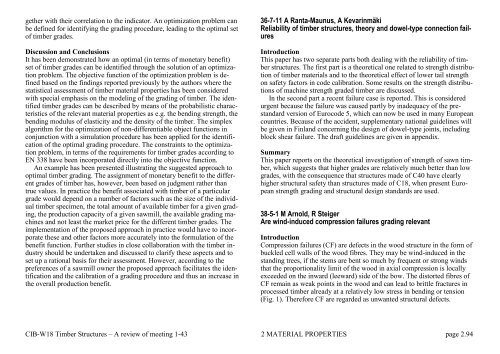CIB-W18 Timber Structures – A review of meeting 1-43 2 MATERIAL ...
CIB-W18 Timber Structures – A review of meeting 1-43 2 MATERIAL ...
CIB-W18 Timber Structures – A review of meeting 1-43 2 MATERIAL ...
- TAGS
- timber
- structures
- cib-w18.com
Create successful ePaper yourself
Turn your PDF publications into a flip-book with our unique Google optimized e-Paper software.
gether with their correlation to the indicator. An optimization problem can<br />
be defined for identifying the grading procedure, leading to the optimal set<br />
<strong>of</strong> timber grades.<br />
Discussion and Conclusions<br />
It has been demonstrated how an optimal (in terms <strong>of</strong> monetary benefit)<br />
set <strong>of</strong> timber grades can be identified through the solution <strong>of</strong> an optimization<br />
problem. The objective function <strong>of</strong> the optimization problem is defined<br />
based on the findings reported previously by the authors where the<br />
statistical assessment <strong>of</strong> timber material properties has been considered<br />
with special emphasis on the modeling <strong>of</strong> the grading <strong>of</strong> timber. The identified<br />
timber grades can be described by means <strong>of</strong> the probabilistic characteristics<br />
<strong>of</strong> the relevant material properties as e.g. the bending strength, the<br />
bending modulus <strong>of</strong> elasticity and the density <strong>of</strong> the timber. The simplex<br />
algorithm for the optimization <strong>of</strong> non-differentiable object functions in<br />
conjunction with a simulation procedure has been applied for the identification<br />
<strong>of</strong> the optimal grading procedure. The constraints to the optimization<br />
problem, in terms <strong>of</strong> the requirements for timber grades according to<br />
EN 338 have been incorporated directly into the objective function.<br />
An example has been presented illustrating the suggested approach to<br />
optimal timber grading. The assignment <strong>of</strong> monetary benefit to the different<br />
grades <strong>of</strong> timber has, however, been based on judgment rather than<br />
true values. In practice the benefit associated with timber <strong>of</strong> a particular<br />
grade would depend on a number <strong>of</strong> factors such as the size <strong>of</strong> the individual<br />
timber specimen, the total amount <strong>of</strong> available timber for a given grading,<br />
the production capacity <strong>of</strong> a given sawmill, the available grading machines<br />
and not least the market price for the different timber grades. The<br />
implementation <strong>of</strong> the proposed approach in practice would have to incorporate<br />
these and other factors more accurately into the formulation <strong>of</strong> the<br />
benefit function. Further studies in close collaboration with the timber industry<br />
should be undertaken and discussed to clarify these aspects and to<br />
set up a rational basis for their assessment. However, according to the<br />
preferences <strong>of</strong> a sawmill owner the proposed approach facilitates the identification<br />
and the calibration <strong>of</strong> a grading procedure and thus an increase in<br />
the overall production benefit.<br />
36-7-11 A Ranta-Maunus, A Kevarinmäki<br />
Reliability <strong>of</strong> timber structures, theory and dowel-type connection failures<br />
Introduction<br />
This paper has two separate parts both dealing with the reliability <strong>of</strong> timber<br />
structures. The first part is a theoretical one related to strength distribution<br />
<strong>of</strong> timber materials and to the theoretical effect <strong>of</strong> lower tail strength<br />
on safety factors in code calibration. Some results on the strength distributions<br />
<strong>of</strong> machine strength graded timber are discussed.<br />
In the second part a recent failure case is reported. This is considered<br />
urgent because the failure was caused partly by inadequacy <strong>of</strong> the prestandard<br />
version <strong>of</strong> Eurocode 5, which can now be used in many European<br />
countries. Because <strong>of</strong> the accident, supplementary national guidelines will<br />
be given in Finland concerning the design <strong>of</strong> dowel-type joints, including<br />
block shear failure. The draft guidelines are given in appendix.<br />
Summary<br />
This paper reports on the theoretical investigation <strong>of</strong> strength <strong>of</strong> sawn timber,<br />
which suggests that higher grades are relatively much better than low<br />
grades, with the consequence that structures made <strong>of</strong> C40 have clearly<br />
higher structural safety than structures made <strong>of</strong> C18, when present European<br />
strength grading and structural design standards are used.<br />
38-5-1 M Arnold, R Steiger<br />
Are wind-induced compression failures grading relevant<br />
Introduction<br />
Compression failures (CF) are defects in the wood structure in the form <strong>of</strong><br />
buckled cell walls <strong>of</strong> the wood fibres. They may be wind-induced in the<br />
standing trees, if the stems are bent so much by frequent or strong winds<br />
that the proportionality limit <strong>of</strong> the wood in axial compression is locally<br />
exceeded on the inward (leeward) side <strong>of</strong> the bow. The distorted fibres <strong>of</strong><br />
CF remain as weak points in the wood and can lead to brittle fractures in<br />
processed timber already at a relatively low stress in bending or tension<br />
(Fig. 1). Therefore CF are regarded as unwanted structural defects.<br />
<strong>CIB</strong>-<strong>W18</strong> <strong>Timber</strong> <strong>Structures</strong> <strong>–</strong> A <strong>review</strong> <strong>of</strong> <strong>meeting</strong> 1-<strong>43</strong> 2 <strong>MATERIAL</strong> PROPERTIES page 2.94














